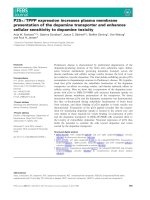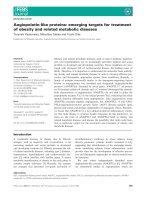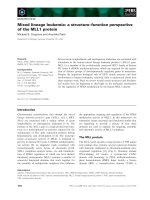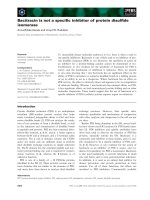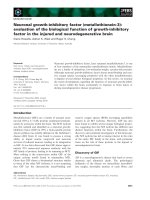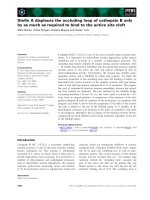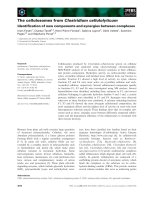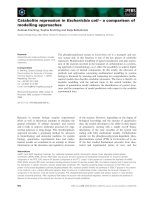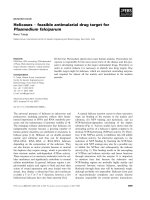Tài liệu Báo cáo khoa học: "Keyword Extraction using Term-Domain Interdependence for Dictation of Radio News" ppt
Bạn đang xem bản rút gọn của tài liệu. Xem và tải ngay bản đầy đủ của tài liệu tại đây (415.75 KB, 5 trang )
Keyword Extraction using Term-Domain Interdependence for
Dictation of Radio News
Yoshimi Suzuki Fumiyo Fukumoto Yoshihiro Sekiguchi
Dept. of Computer Science and Media Engineering
Yamanashi University
4-3-11 Takeda, Kofu 400 Japan
{ysuzuki@suwa, fukumot o@skyo, sokiguti©saiko}, osi. yamanashi, ac. jp
Abstract
In this paper, we propose keyword extraction
method for dictation of radio news which con-
sists of several domains. In our method, news-
paper articles which are automatically classified
into suitable domains are used in order to calcu-
late feature vectors. The feature vectors shows
term-domain interdependence and are used for
selecting a suitable domain of each part of ra-
dio news. Keywords are extracted by using the
selected domain. The results of keyword extrac-
tion experiments showed that our methods are
robust and effective for dictation of radio news.
1 Introduction
Recently, many speech recognition systems
are designed for various tasks. However, most
of them are restricted to certain tasks, for ex-
ample, a tourist information and a hamburger
shop. Speech recognition systems for the task
which consists of various domains seems to be
required for some tasks, e.g. a closed caption
system for TV and a transcription system of
public proceedings. In order to recognize spoken
discourse which has several domains, the speech
recognition system has to have large vocabu-
lary. Therefore, it is necessary to limit word
search space using linguistic restricts, e.g. do-
main identification.
There have been many studies of do-
main identification which used term weight-
ing (J.McDonough et al., 1994; Yokoi et al.,
1997). McDonough proposed a topic identifi-
cation method on switch board corpus. He re-
ported that the result was best when the num-
ber of words in keyword dictionary was about
800. In his method, duration of discourses of
switch board corpora is rather long and there
are many keywords in the discourse. However,
for a short discourse, there are few keywords
in a short discourse. Yokoi also proposed a
topic identification method using co-occurrence
of words for topic identification (Yokoi et al.,
1997). He classified each dictated sentence of
news into 8 topics. In TV or Radio news, how-
ever, it is difficult to segment each sentence au-
tomatically. Sekine proposed a method for se-
lecting a suitable sentence from sentences which
were extracted by a speech recognition system
using statistical language model (Sekine, 1996).
However, if the statistical model is used for ex-
traction of sentence candidates, we will obtain
higher recognition accuracy.
Some initial studies of transcription of broad-
cast news proceed (Bakis et al., 1997). However
there are some remaining problems, e.g. speak-
ing styles and domain identification.
We conducted domain identification and key-
word extraction experiment (Suzuki et al.,
1997) for radio news. In the experiment,
we classified radio news into 5 domains (i.e.
accident, economy, international, politics and
sports). The problems which we faced with are;
1. Classification of newspaper articles into
suitable domains could not be performed
automatically.
2. Many incorrect keywords are extracted, be-
cause the number of domains was few.
In this paper, we propose a method for key-
word extraction using term-domain interdepen-
dence in order to cope with these two problems.
The results of the experiments demonstrated
the effectiveness of our method.
2 An overview of our method
Figure 1 shows an overview of our method.
Our method consists of two procedures. In the
procedure of term-domain interdependence cal-
culation, the system calculates feature vectors
1272
of term-domain interdependence using an ency-
clopedia of current term and newspaper articles.
In the procedure of keyword extraction in radio
news, firstly, the system divides radio news into
segments according to the length of pauses. We
call the segments units. The domain which has
the largest similarity between the unit of news
and the feature vector of each domain is selected
as domain of the unit. Finally, the system ex-
tracts keywords in each unit using the feature
vector of selected domain which is selected by
domain identification.
Explanations of~ ~ Radio News
n en,~pediaJ
Lar~icle~=i"~' j
Q::::::::::::::l
Feature
vectors
caVe)
D1
D7
[~
D141
Feature
vectors
(FeaVa) ,~
D1 [~ Domain identification
D7
"0"
ID3 ID7 D18 1
©
[~ Keyword Extraction
D141 *:~
I President
]
I
[ {,
Democratic partyJl
Keyword extraction
Calculation of term-domain
interdependence
Figure 1: An overview of our method
3 Calculating feature vectors
In the procedure of term-domain interdepen-
dence calculation, We calculate likelihood of ap-
pearance of each noun in each domain. Figure 2
shows how to calculate feature vectors of term-
domain interdependence.
In our previous experiments, we used 5 do-
mains which were sorted manually and calcu-
lated 5 feature vectors for classifying domains of
each unit of radio news and for extracting key-
words. Our previous system could not extract
some keywords because of many noisy keywords.
In our method, newspaper articles and units of
radio news are classified into many domains. At
each domain, a feature vector is calculated by
an encyclopedia of current terms and newspaper
articles.
3.1" Sorting newspaper articles
according to their domains
Firstly, all sentences in the encyclopedia are
analyzed morpheme by Chasen (Matsumoto et
An encyclopedia of current terms 1
41domains 10,236
explanations)
©
ISorting
explanations
]
Q
Newspaper articles
about
110,000 articles.,/
©
[Separa~articles I
[ Extra~:~nouns I
IE~rac~'~ n°unsl
i Calculating frequ~ vectors (FreqVa) I
ICalculating frequency vectors (FreqVe)l
._1 Calculating similarity I
. ~'~
between FeaVe and
FreqVa I
Calculating X values of | ' _r-L
J each noun on domains J X,,7
I I Sorting articles into domains
. V . I laccording to simitarity I
~41 feature vectors (FeaVe)~ I .:~
Calculating x:values of
each noun on doma ns
©
041 feature vectors (FeaVa)~
Figure
2:
Calculating feature vectors
al., 1997) and nouns which frequently appear
are extracted. A feature vector is calculated by
frequency of each noun at each domain. We
call the feature vector
FeaVe.
Each element
of
FeaVe
is a X 2 value (Suzuki et al., 1997).
Then, nouns are extracted from newspaper ar-
ticles by a morphological analysis system (Mat-
sumoto et al., 1997), and frequency of each noun
are counted. Next, similarity between
FeaVe
of
each domain and each newspaper article are cal-
culated by using formula (1). Finally, a suitable
domain of each newspaper article are selected by
using formula (2).
Sirn(i,j) = FeaVej. FreqVai
(1)
Dornainl
= arg max
Sim(i,j)
(2)
I~j~N
where i means a newspaper article and j means
a domain. (.) means operation of inner vector.
3.2 Term-domain interdependence
represented by feature vectors
Firstly, at each newspaper articles, less than
5 domains whose similarities between each ar-
ticle and each domain are large are selected.
Then, at each selected domain, the frequency
vector is modified according to similarity value
and frequency of each noun in the article. For
example, If an article whose selected domains
are "political party" and "election", and simi-
larity between the article and "political party"
1273
and similarity between the article and "elec-
tion" are 100 and 60 respectively, each fre-
quency vector is calculated by formula (3) and
formula (4).
100
FreqVm = FreqV~ + FreqVal
x 1-~ (3)
60
freqV~l = FreqV~z + freqVai
x 1-~ (4)
where i means a newspaper article.
Then, we calculate feature vectors
FeaVa
us-
ing
FreqV
using the method mentioned in our
previous paper (Suzuki et al., 1997). Each el-
ement of feature vectors shows X 2 value of the
domain and wordk. All wordk (1 < k < M :M
means the number of elements of a feature vec-
tor) are put into the keyword dictionary.
4 Keyword extraction
Input news stories are represented by
phoneme lattice. There are no marks for word
boundaries in input news stories. Phoneme lat-
tices are segmented by pauses which are longer
than 0.5 second in recorded radio news. The
system selects a domain of each unit which is
a segmented phoneme lattice. At each frame of
phoneme lattice, the system selects maximum
20 words from keyword dictionary.
4.1 Similarity between a domain and
an unit
We define the words whose X 2 values in
the feature vector of domainj are large as key-
words of the domainj. In an unit of radio
news about "political party", there are many
keywords of "political party" and the X 2 value
of keywords in the feature vector of "political
2
party" is large. Therefore, sum of
Xw,pollticalparty
tends to be large (w : a word in the unit). In our
method, the system selects a word path whose
2 is maximized in the word lattice sum of Xkj
at domaini. The similarity between unit/ and
domainj is calculated by formula (5).
Sim(i, j) = max Sim'(i, j)
all paths
= max np(wordk) x Xk,15)
all paths
In formula (5), wordk is a word in the
word lattice, and each selected word does not
share any frames with any other selected words.
np(wordk) is the number of phonemes of wordk.
2
Xk,j is x2value of wordk for domainj.
The system selects a word path whose
Siml(i,j)
is the largest among all word paths
for domainj.
Figure 3 shows the method of calculating sim-
ilarity between unit/ and domainD1. The sys-
tem selects a word path whose
Sim~(uniti,
D1)
is larger than those of any other word paths.
phoneme lattice of
uni~
andidates
i-
Si~unit.
DI ) =max(3.2x3+ 0.5x6,3,2x3+ 4.3x4+ 0.7× 2,
3.2x3+ 4.3x4+ 4.3x3,
1.2 x 3+ 0.3 x 4, )
Figure 3: Calculating similarity between unit/
and D1
4.2 Domain identification and keyword
extraction
In the domain identification process, the sys-
tem identifies each unit to a domain by formula
(5). If
Sim(i,j)
is larger than similarities be-
tween an unit and any other domains, domainj
seems to be the domain of unit~. The system se-
lects the domain which is the largest of all sim-
ilarities in N of domains as the domain of the
unit (formula (6)) . The words in the selected
word path for selected domain are selected as
keywords of the unit.
Domaini
= arg max
Sim(i,j)
(6)
X<j<N "
5 Experiments
5.1 Test data
The test data we have used is a radio news
which is selected from NHK 6 o'clock radio news
in August and September of 1995. Some news
stories are hard to be classified into one do-
main in radio news by human. For evalua-
tion of domain identification experiments, we
1274
selected news stories which two persons classi-
fied into the same domains are selected. The
units which were used as test data are seg-
mented by pauses which are longer than 0.5
second. We selected 50 units of radio news for
the experiments. The 50 units consisted of 10
units of each domain. We used two kinds of test
data. One is described with correct phoneme
sequence. The other is written in phoneme lat-
tice which is obtained by a phoneme recognition
system (Suzuki et al., 1993). In each frame of
phoneme lattice, the number of phoneme candi-
dates did not exceed 3. The following equations
show the results of phoneme recognition.
the
number of correct phonemes in
phoneme lattice
the number of uttered phonemes
the number of correct phonemes in
phoneme lattice
phoneme segments in phoneme lattice
= 95.6%
= 81.2%
5.2 Training
data
In order to classify newspaper articles into
small domain, we used an encyclopedia of cur-
rent terms "Chiezo"(Yamamoto, 1995). In the
encyclopedia, there are 141 domains in 9 large
domains. There are 10,236 head-words and
those explanations in the encyclopedia. In or-
der to calculate feature vectors of domains, all
explanations in the encyclopedia are performed
morphological analysis by Chasen (Matsumoto
et al., 1997). 9,805 nouns which appeared more
than 5 times in the same domains were selected
and a feature vector of each domain was cal-
culated. Using 141 feature vectors which were
calculated in the encyclopedia, we identified do-
mains of newspaper articles. We identified do-
mains of 110,000 articles of newspaper for cal-
culating feature vectors automatically. We se-
lected 61,727 nouns which appeared at least 5
times in the newspaper articles of same domains
and calculated 141 feature vectors.
5.3 Domain identification experiment
The system selects suitable domain of each
unit for keyword extraction. Table I shows
the results of domain identification. We con-
ducted domain identification experiments using
two kinds of input data, i.e. correct phoneme
sequence and phoneme lattice and two kinds of
domains, i.e. 141 domains and 9 large domains.
We also compared the results and the result us-
ing previous method (Suzuki et al., 1997). For
comparison, we selected 5 domains which are
used by previous method in our method. In
previous method, we used a keyword dictionary
which has 4,212 words.
Table 1: The result of domain identification
number of Correct Phoneme
method domains phoneme lattice
our 141 62% 40%
method 9 78% 54%
5 90% 82%
previous 5 86% 78%
method
5.4 Keyword extraction experiment
We have conducted keyword extraction ex-
periment using the method with 141 feature
vectors (our method), 5 feature vectors (pre-
vious method) and without domain identifica-
tion. Table 2 shows recall and precision which
are shown in formula (7), and formula (8), re-
spectively, when the input data was phoneme
lattice.
the number of correct words in
recall = MSKP
the number of selected words in (7)
MSKP
the number of correct words
precision = in MSKP
the number of correct nouns (8)
in the unit
MSKP : the most suitable keyword path for se-
lected domain
6 Discussion
6.1
Sorting newspaper
articles
according to their domains
For using X 2 values in feature vectors, we
have good result of domain identification of
newspaper articles. Even if the newspaper ar-
ticles which are classified into several domains,
the suitable domains are selected correctly.
6.2 Domain identification of radio news
Table I shows that when we used 141 kinds of
domains and phoneme lattice, 40% of units were
identified as the most suitable domains by our
1275
Table 2: Recall and precision of keyword extrac-
tion
Method R/P
our method R
(141 domains) P
previous method R
(5 domains) P
without DI R
. (1 domain) P
Correct
phoneme
Phoneme
lattice
88.5% 48.9%
69.0% 38.1%
80.0%
63.1%
77.0%
60.1%
24.0%
33.0%
12.2%
9.5%
R: recall P: precision Dh domain identification
method and shows that when we used 9 kinds
of domains and phoneme lattice, 54% of units
are identified as the most suitable domains by
our method. When the number of domains was
5, the results using our method are better than
our previous experiment. The reason is that we
use small domains. Using small domains, the
number of words whose X 2 values of a certain
domain are high is smaller than when large do-
mains are used.
For further improvement of domain identifi-
cation, it is necessary to use larger newspaper
corpus in order to calculate feature vectors pre-
cisely and have to improve phoneme recogni-
tion.
6.3 Keyword extraction of radio news
When we used our method to phoneme lat-
tice, recall was 48.9% and precision was 38.1%.
We compared the result with the result of our
previous experiment (Suzuki et al., 1997). The
result of our method is better than the our pre-
vious result. The reason is that we used do-
mains which are precisely classified, and we can
limit keyword search space. However recall was
48.9% using our method. It shows that about
50% of selected keywords were incorrect words,
because the system tries to find keywords for
all parts of the units. In order to raise recall
value, the system has to use co-occurrence be-
tween keywords in the most suitable keyword
path.
7 Conclusions
In this paper, we proposed keyword extrac-
tion in radio news using term-domain interde-
pendence. In our method, we could obtain
sorted large corpus according to domains for
keyword extraction automatically. Using our
method, the number of incorrect keywords in
extracted words was smaller than the previous
method.
In future, we will study how to select correct
words from extracted keywords in order to ap-
ply our method for dictation of radio news.
8 Acknowledgments
The authors would like to thank Mainichi
Shimbun for permission to use newspaper arti-
cles on CD-Mainichi Shimbun 1994 and 1995,
Asahi Shimbun for permission to use the data
of the encyclopedia of current terms "Chiezo
1996" and Japan Broadcasting Corporation
(NHK) for permission to use radio news. The
authors would also like to thank the anonymous
reviewers for their valuable comments.
References
Baimo Bakis, Scott Chen, Ponani Gopalakrishnan,
Ramesh Gopinath, Stephane Maes, and Lazaros
Pllymenakos. 1997. Transcription of broadcast
news - system robustness issues and adaptation
techniques. In
Proc. ICASSP'97,
pages 711-714.
J.McDonough, K.Ng, P.Jeanrenaud, H.Gish, and
J.R.Rohlicek. 1994. Approaches to topic identifi-
cation on the switchboard corpus. In
Proc. IEEE
ICASSP'94,
volume 1, pages 385-388.
Yuji Matsumoto, Akira Kitauchi, Tatuo Yamashita,
Osamu Imaichi, and Tomoaki Imamura, 1997.
Japanese Morphological Analysis System ChaSen
Manual.
Matsumoto Lab. Nara Institute of Sci-
ence and Technology.
Satoshi. Sekine. 1996. Modeling topic coherence for
speech recognition. In
Proc. COLING 96,
pages
913-918.
Yoshimi Suzuki, Chieko Furuichi, and Satoshi Imai.
1993. Spoken japanese sentence recognition us-
ing dependency relationship with systematical
semantic category.
Trans. of IEICE J76 D-II,
11:2264-2273. (in Japanese).
Yoshimi Suzuki, Fumiyo Fukumoto, and Yoshihiro
Sekiguchi. 1997. Keyword extraction of radio
news using term weighting for speech recognition.
In
NLPRS97,
pages 301-306.
Shin Yamamoto, editor. 1995.
The Asahi Encyclo-
pedia of Current Terms 'Chiezo'.
Asahi Shimbun.
Kentaro Yokoi, Tatsuya Kawahara, and Shuji
Doshita. 1997. Topic identification of news
speech using word cooccurrence statistics. In
Technical Report of IEICE SP96-I05,
pages 71-
78. (in Japanese).
1276
